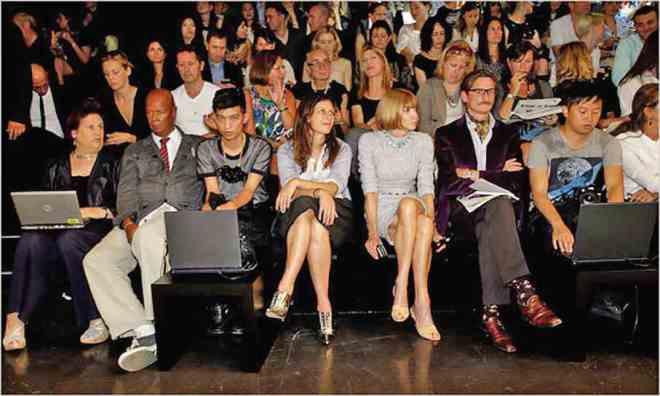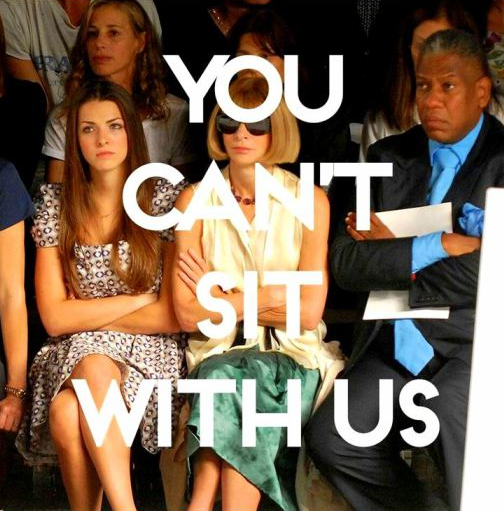NOT LONG AGO I hosted a dinner at the London College of Fashion’s Fashion Space Gallery, themed around writing on fashion. Together with a group of journalists, editors, bloggers and scholars we spent the evening debating what it is that makes a fashion writer good, what ‘integrity’ means to a fashion writer, why criticism in fashion writing isn’t encouraged in mainstream fashion publications and if it is fair to expect an unbiased view of the fashion industry from publications dependent on advertising for their survival.
Getting members of the fashion industry to speak candidly and on the record about the often-fraught affiliation between journalists and fashion brands is not an easy feat, and the ambivalent relationship that many writers have to the fashion system was evident already in the responses I received to my dinner invitation. ‘Will we be recorded?’ was a question asked more than once. One very well known fashion journalist declined by saying: ‘I feel that we are now just garnish for fashion PRs and designers. Few people read what we say, we are not the gatekeepers any more, and none of it matters. So I am feeling bleak and don’t want to talk about it.’ In this environment it’s apt to ask what role and importance those writing about fashion have. How can we make what we do matter?
It’s an open secret in the industry that advertising brands dictate editorial content, sometimes explicitly, often tacitly. Stories of reporters being banned from shows after unfavourable reviews belong to fashion folklore, but accounts of PR people demanding final approval of articles, interviews being cut short after an uncomfortable question and designers bringing their own recording devices to interviews are surprisingly common. The PR being a silent witness to a designer interview is today so routine that it fails to even raise eyebrows. What journalists tend to talk less about are the generous gifts sometimes bestowed upon us after a favourable article (sending it back would be rude, keeping it feels like an implicit understanding that more good reviews will follow) or the difficulty many of us find when it comes to writing critically about someone you know and like (and will be bumping into at the next industry event).
In Vestoj’s issue ‘On Fashion & Power’, American Vogue editor Hamish Bowles remarks that: ‘Fashion advertising and editorial complement each other. Fashion is all about creating desire, and both advertisers and editors want to seduce the consumer; after all, that’s our job.’ While it’s no doubt true that fashion editorial content is enmeshed with advertiser interest, it’s hardly the only industry where advertising plays a vital role in sales, or where PR machinations have an ever-increasing role in the business. It is however worth pointing out that, as opposed to a music or film critic, a fashion journalist or editor barred from participating in industry affairs is, in effect, prevented from doing their job. Being black listed in the books of a specific brand often means not only being banned from fashion shows but also being blocked from potential interviews and even the borrowing of garments for fashion shoots. A few of those embargos and a publication can very quickly become, to all intents and purposes, irrelevant in terms of fashion capital. To write credibly about the fashion system you need to operate within its parameters. Fashion values exclusivity, it is hegemonic and self-reinforcing. As the editor of a much respected biannual recently wrote to me to turn down an invitation to participate in Vestoj’s issue ‘On Fashion and Power’: ‘Surely you realise that people in the industry are there not only because they understand these power structures but also because they love to know about them (though not necessarily approve of them, as you say). Why on earth would they then jeopardise that vantage point? Surely they value participating in them (whether subversively or not) more than communicating about them and thereby shutting themselves out?’ Put more plainly – you don’t bite the hand that feeds you.
In this climate it’s hardly surprising that magazines like Gentlewoman or Acne Paper are often listed when insiders are asked to name ‘good’ fashion publications. Sophisticated-looking and full of lengthy articles, these are magazines that appeal to our urbane side and that flatter our view of ourselves as discerning fashion consumers as well as participants. But what is it that distinguishes a gushing profile of Prada’s Verde Visconti in the recent issue of Gentlewoman (not far from the ubiquitous ad by the same label) from an obsequious review of the brand on Style.com or an editorial full of ‘total looks’ in any one of the current crop of fashion glossies? To paraphrase Hamish Bowles, publications about fashion today are primarily in the business of seducing the consumer, and of selling clothes. Be it in the straightforward manner of advertising or the more insidious approach outlined above, the result remains the same: the editor’s freedom is nominal, and big brands rule the roost.
The fashion industry today is a place where most insiders are keenly aware of the lack of autonomy afforded reporters and critics, and the neutering influence that status and prestige has on critical thinking. Like a legion of Janus-faced cohorts we make use of our professional face when necessary and switch to our private face when the proverbial tape recorder is finally turned off. Though fashion is not the only industry where its practitioners have great difficulty seeing their own part in what they don’t like, it is one where we aren’t often held accountable for it. Instead we make concessions, come up with excuses and, when that doesn’t work, we simply learn to live with the discrepancies. So whereas I’m greatly tempted to continue and turn this into a further rallying call for disgruntled fashion professionals, I will stop here. Fighting the system, after all, isn’t for everybody. What we all can do however, is to look for cracks in it. The chinks and fissures of any structure is where the most intriguing things are often found, the fashion system is no different. So scratch the surface, question the perceived knowledge and bring a critical eye to those admired uncritically. Only then can what we do begin to really matter.
Anja Aronowsky Cronberg is Vestoj’s Editor-in-Chief and Publisher.

